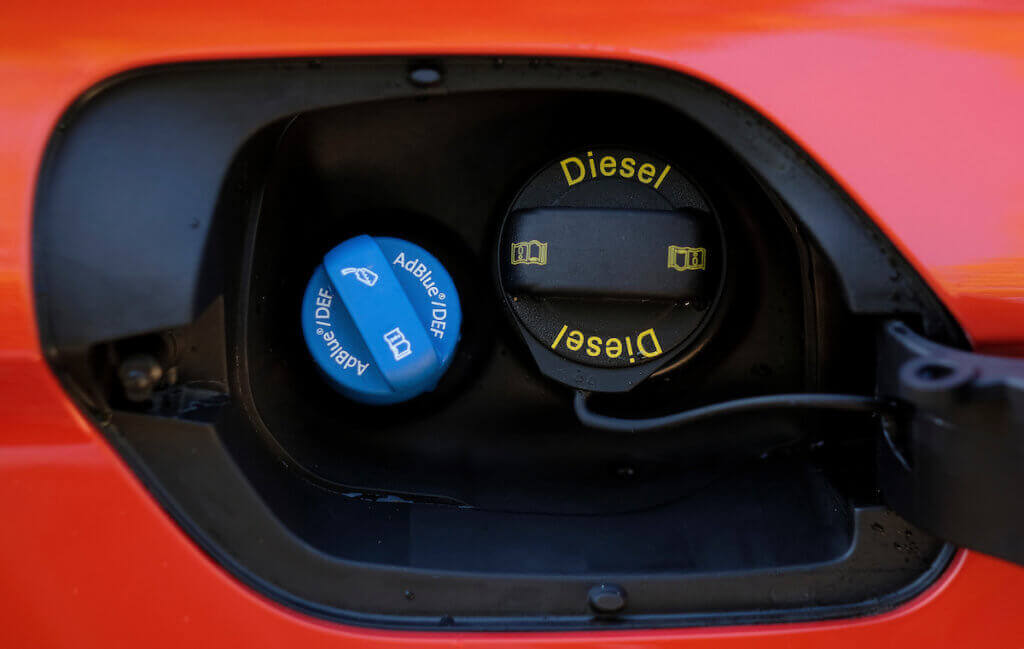AdBlue helps to reduce harmful emissions and ensures that your car stays compliant with certain environmental standards.
Many modern diesel cars won't even start without it - and you need it if you want your vehicle to pass the MOT emissions test.
Read on and find out everything you need to know about AdBlue in 2024.
Page Contents
What Is AdBlue?
AdBlue is a commonly used Diesel Exhaust Fluid (DEF) in Europe, though other regions may use alternative DEF brands.
It is a trade name registered by the German car manufacturers association, so not every car uses it.
AdBlue is a colourless, non-toxic liquid stored in a separate tank, usually next to your diesel tank.
It is not a fuel additive but a method of limiting the emissions produced by diesel cars.
AdBlue contains 2 parts deionised water and 1 part concentrated automotive urea.
Automotive urea contains Ammonia and Carbon Dioxide.
What Does AdBlue Do?
AdBlue reduces the levels of harmful exhaust emissions in diesel cars.
It became compulsory for all diesel vehicles to use a form of DEF in September 2015 when the EU introduced Euro 6, their strictest emissions standard yet.
It works alongside the Diesel Particulate Filter (DPF) to reduce harmful emissions.
The DPF reduces particulate matter, whilst AdBlue reduces Nitrogen Oxides (NOx) through a process called Selective Catalytic Reduction (SCR).
Not every diesel car will use AdBlue - smaller or older diesel engines may rely on different emissions control systems, like Exhaust Gas Recirculation (EGR).
Only diesel vehicles equipped with SCR systems will need AdBlue.
AdBlue does not affect CO2 emissions, as its levels are controlled by fuel efficiency measures rather than AdBlue or DPFs.
How Does AdBlue Reduce Exhaust Emissions?
Your vehicle carefully injects AdBlue into the exhaust gases produced by your engine.
The ammonia in the urea breaks down the NOx emissions through a series of chemical reactions.
This means your exhaust releases Nitrogen and water vapour into the atmosphere instead of any harmful emissions.
As a result, AdBlue and other DEFs can reduce NOx emissions by up to 90%.
This is especially important as Euro 7 emissions standards have introduced stricter NOx emissions limits.
In short, AdBlue helps to make the air cleaner and lowers the emissions that impact us all.
Does AdBlue Affect Fuel Consumption?
There is no evidence that AdBlue negatively affects fuel consumption.
It focuses on reducing exhaust emissions, so it doesn't mix with diesel at all.
Some vehicles' fuel consumption does benefit from using it (because it optimises combustion) but this is already integrated into manufacturers' figures.
How Do I Top AdBlue Up?
To top up your car's AdBlue levels, you will first need to located the AdBlue tank.
This is usually next to the diesel tank, but can also be found under the bonnet.
Check your vehicle handbook if you're struggling.
Using a funnel or anti-spill nozzle, slowly pour AdBlue from the container into your tank.
Use as much as you need to completely fill the tank.
Whilst AdBlue isn't classified as toxic, it can still harm the environment if it spills into a water source - and can do damage to your skin and eyes if you don't handle it safely.
If your car needs a dashboard reset after a top-up, make sure you complete this as per the instructions in your vehicle handbook.
Make sure your onboard computer has validated the refill before restarting the engine.
This comes in the form of a dashboard message and may take a couple of minutes to come through.

How Much Does AdBlue Cost?
The cost of AdBlue can vary depending on which brand you choose and how you choose to fill it up.
On average, a 10-litre container costs between £10 and £15.
If you choose a public pump, you will pay per litre.
This price will vary from pump to pump.
If you book your AdBlue top-up through BookMyGarage, it costs £20 for up to 10 litres.
Where Can I Find an AdBlue Pump Near Me?
Trucks and HGVs have used AdBlue since 2001, so there are plenty of public top-up points at motorway service stations.
However, some may not have been converted to work for cars, so check before you travel if you suspect your tank needs filling up.
Findadblue helps you find your closest AdBlue pump or retailer.
You can search by car brand or by their official partners and you just need to enter your postcode to see the entire list.
How Much AdBlue Do You Need?
You need between 10 and 11.5 litres to fill an AdBlue tank, on average.
Larger vehicles will need slightly more because their tanks are bigger.
However, you may need slightly less to completely top your tank up if you're refilling it just after the warning light came on.
What Does the AdBlue Light Mean?
When your car starts to run low on AdBlue, you may see the following warning light (or something similar).
The AdBlue light in your car may resemble a liquid being poured from a container.

If you see the AdBlue warning light, this means you have about 1,500 miles of fluid left.
You should look to fill up your tank as soon as possible to avoid it running out.
How Do You Reset the AdBlue Light?
The best way to clear the AdBlue warning light is to refill your AdBlue tank.
Once the tank is full, turn the ignition on for about 30 seconds - without starting the engine - and make sure the warning light clears.
If the light doesn't clear, there may be an issue with the system.
This is commonly a fault with one of the sensors but it could be something else.
Each vehicle has a specific process to reset the AdBlue light.
Consult your vehicle handbook to find out how to do so for your car.
If you're still not sure what to do or the warning light persists, ask a professional mechanic for help.
Common AdBlue Problems
Some of the most common AdBlue-related car issues include:
- AdBlue crystallisation
- Contaminated AdBlue
- Freezing AdBlue
- Injector failures
- Pump failure
- AdBlue tank level sensor fault
- NOx sensor failure
When AdBlue is exposed to air, the water component evaporates, leaving behind solid urea deposits.
AdBlue crystalisation can clog filters, block injectors and reduce the efficiency of the SCR system.
Even a small amount of dirt, oil, or other contaminants in the AdBlue can degrade its quality - potentially leading to damage in the SCR system.
AdBlue can freeze below 11 degrees C - meaning it cannot be injected into the exhaust system until it thaws.
Most modern vehicles are equipped with heated AdBlue tanks or lines to cope with this problem, though, so freezing is likely only going to be an issue for older systems or in extreme cold conditions.
Faulty AdBlue level sensors may cause incorrect warnings about low levels, while NOx sensor failures can trigger false alerts or inaccurate monitoring of emissions levels.
Mechanical and electrical failures in the pump can disrupt the AdBlue system, too.
If you're trying to troubleshoot your car's AdBlue problem, the following tips can help:
- Buy quality AdBlue
- Top up AdBlue regularly
- Store AdBlue properly
- Don't mix non-certified AdBlue brands
- Stick to manufacturer-recommended maintenance schedules
Knowing about these common AdBlue problems can help you address them in a timely manner and stay compliant with environmental regulations.
Which Cars Use AdBlue?
AdBlue is not fitted to every diesel car. As it is a registered trademark, not every manufacturer is authorised to use it.
The cars in the following lists all use AdBlue.
Audi
- A4 Avant
- A6 Avant
- A4 Saloon
- A5 Sportback
- A7 Sportback
- A8
- Q3
- Q5
- Q7
BMW
- Series 5 Saloon
- Series 5 Touring
- Series 7 Saloon
- X5
- X6
Citroen
- Berlingo Multispace
- C3
- C4 Cactus
Jaguar
- XE
- XF
- XJ
Land Rover
- Discovery
- Discovery Sport
- Range Rover Evoque
- Range Rover
- Range Rover Sport
Peugeot
- 208
- 2008
- 308
- 30008
- 508
- 508SW
- 5008
- Partner Tepee
- Traveller
Volkswagen
- Caddy
- California
- Caravelle
- Passat
- Passat Alltrack
- Tiguan
- Toureg
- Transporter
Mercedes-Benz
- C-Class Saloon
- CLS
- E-Class Saloon
- G-Class
- GLC
- GLE
- Sprinter
- S-Class Saloon
- Vito
If your car is not one of the models listed above, it may use a different type of DEF or emissions-reducing technology.
You can consult your vehicle handbook for more information.
Petrol vehicles do not use AdBlue.
Is All AdBlue the Same?
There are several different types of AdBlue.
These are differentiated by International Organisation for Standardisation (ISO) 22241 numbers.
ISOs ensure that the AdBlue you use is effective and has been created to the proper specifications.
Modern diesel cars run on ISO-22241-1, ISO-22241-2, or ISO-22241-3.
If you are unsure which type your car uses, consult your vehicle handbook.
How Long Does It Last?
A full tank of AdBlue lasts between 6,000 and 7,000 miles, on average.
1 litre of AdBlue lasts around 600 miles, but this can be affected by your driving style.
The more fuel your vehicle uses, the more AdBlue it will consume as well.
Travelling 6,000 to 7,000 miles will empty your tank.
We recommend topping up every 5,000 miles to be on the safe side.
What Happens if You Run Out of AdBlue?
If your car runs out of AdBlue, it will enter 'limp home' mode.
Limp home mode limits your vehicle's power and performance, allowing you to get home or to a garage safely.
However, once you switch the engine off, it won't restart until you fill up your AdBlue tank.
Can I Put AdBlue in the Diesel Tank?
AdBlue is not a fuel additive and should never be added directly into the diesel tank.
If you suspect these have mixed together, do not start the car.
Call your recovery provider and get them to tow you to a garage where a mechanic can assess the damage.
What Happens if I Put Diesel in the AdBlue Tank?
Even the smallest amount of diesel can contaminate the entire AdBlue tank.
It can also cause serious damage to your exhaust system - which can be expensive to fix.
You might notice your car behaving oddly if you do start driving.
If your fuel level doesn't seem to have changed, your car feels strange or you see any warning lights after filling up, pull over as soon as possible and call your recovery provider.
If you accidentally put diesel in your AdBlue tank, the best thing to do is stay where you are and call your recovery provider.
To avoid expensive damage, do not start the engine.
Where Can You Buy AdBlue?
You can buy AdBlue at:
- Some motorway service stations
- Automotive suppliers
- Local garages
Alternatively, you can enter your vehicle reg and postcode into our online booking tool to compare thousands of garages offering AdBlue top-ups near you and book your appointment in just a few clicks.
You can add it onto any MOT, service, or other repair you need to make your life as easy as possible.
FAQs
How Will I Know When My AdBlue Tank Is Full?
What Happens When You Overfill the AdBlue Tank?
How Long Can I Drive After The AdBlue Warning Light Comes On?
How Much AdBlue Should I Add?
What Is Selective Catalytic Reduction?







